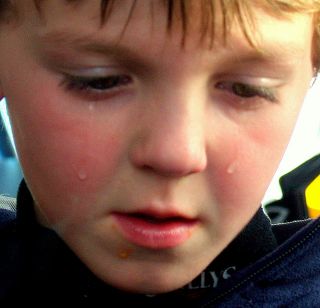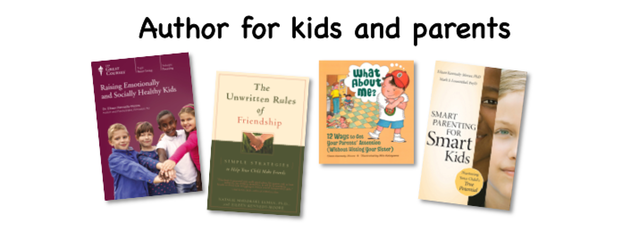Friends
Make New Friends But Keep the Old… Or Not
When children’s friendships end.
Posted May 24, 2012

Make new friends,
But keep the old.
One is silver
And the other gold.
This children’s song expresses a nice ideal: the ever-expanding circle of friends. Sometimes things actually work out that way. I’ve met adults who’ve said, “We’ve been friends since kindergarten!” A friend who has known you forever is a treasure. But friendships don’t always last—especially for children.
Friendships come and go
When I was growing up, my family moved about every three years. The up-side of this was that I got to see different parts of the world, and it made my family very close. I also learned to be pretty good at making new friends, and, to keep in touch with old friends, I became a great letter writer (a lost art and the origin of my career as a writer!). But I was always a bit jealous of kids who stayed in one place and therefore got to keep their friends for a long time. It wasn’t until I was much older, with children of my own, that I learned that children’s friendships can fade or split even when no one moves.
Sometimes children’s friendships end in angry accusations and hurt feelings. Sometimes friends just drift apart. Perhaps the most painful end to a friendship is the one-sided rejection—one friend turns away, or chooses someone else as a close friend, and the other child is left feeling abandoned and wondering why things fell apart.
The end of a friendship is often sad, but it’s not necessarily a bad thing. Sometimes it’s just an unavoidable result of children growing up in different ways or at different rates. The interest in hot wheels that drew two thee-year-old boys together won’t sustain their friendship when they’re ten years old and one plays soccer while the other prefers chess. Sometimes certain pairs of children tend to bring out the worst in each other, and they’re better off finding different, more compatible friends. Often the end of one friendship makes more room for other friendships to grow.
Research on children's friendship stability
In general, older children are better at maintaining friendships than younger children, probably because they are better able to resolve conflicts. A pair of studies by Thomas Berndt and Sally Hoyle looked at “best friendship” stability across the school year for 1st graders (ages 6-7), 4th graders (ages 9-10), and 8th graders (ages 13-14). Among first graders, about half of the close friendships lasted the whole school year, whereas among the older children, around three quarters of these friendships were stable. First and fourth graders tended to gain more friends than they lost from November to April, whereas 8th graders generally lost more friends than they gained. This may reflect a desire for fewer, more intimate friendships among teens. There’s also some evidence that girls’ friendships tend to be less stable than boys’ friendships, perhaps because girls expect more from their friends than boys do, in terms of intimacy and exclusivity.
Friendships in which children interact both in school and out of school tend to be more stable than those that occur in only one context. However, children’s behavior also has a big impact on whether friendships last. Jeffrey Parker and John Seal studied changes in friendship among eight-to fifteen-year old children at a sleep-away summer camp. Children with unstable friendships during the four weeks of camp were rated by their peers as more bossy, physically aggressive, and prone to teasing. Other research suggests that children whose friendships don’t last tend to rate those friendships as less intimate, spend less time with their friends, and comment more on their friends’ disloyalty.
Help your child cope with the end of a friendship
The odds are that at some point your child will face the end of a friendship. If your child is the one being rejected, this may bring out a fierce, protective reaction in you. Don’t go there. As tempting as it might be to call the other parent or speak directly to the other child, the ebbs and flows of friendship are something that children need to sort out on their own. You can empathize, coach, cuddle, or maybe even nudge, but ultimately, only your child can either repair the relationship or move on.
Here are some ideas about how you can help your child cope with the end of a friendship:
-- Empathize with your child’s feelings.
The break-up of a friendship can be very painful. Your child may feel sad, betrayed, angry, hurt, or bewildered. Knowing that you understand can make these feelings easier for your child to bear. While it may be tempting to point out what your child did to contribute to the end of the friendship, hold off on the lectures. If your child is feeling raw, he or she needs comfort rather than criticism. Talking about what to do differently next time can wait until your child is feeling less vulnerable.
-- Discourage retaliation.
If your child is feeling angry, he or she may be tempted to try to “get back” at the former friend in some way. This could mean anything from hitting the other child to gossiping and telling everyone at school what a rotten person the former friend is. This impulse is understandable, but nothing good will come of acting on it. It certainly won’t repair the relationship, and it’s likely to escalate the battle. It could also make your child look less attractive to other potential friends, who don’t necessarily know the whole story.
-- Encourage relationship repair.
Not all friendship endings are permanent. If the rift is not too bad, or the friendship was generally good up until this point, you may want to explain to your child that an argument doesn’t have to mean the end of a friendship. Dear Abby had a useful motto that you may want to share with your child: “The person who is least wrong should apologize first.” Sometimes it helps just to let some time pass for tempers to cool, and then have your child reach out to the former friend in a small, kind way, such as offering a compliment or starting to play together at recess.
-- Help your child recognize when it’s time to let go.
We can’t force someone to like us or to be kind to us. If the other child consistently does mean things or rejects your child’s friendly overtures, there’s no point in continuing to try to be friends. Children change, so maybe things will be different down the road, but right now, if the other child refuses to be a friend, your child needs to take a step back.
-- Encourage multiple friendships.
Because children’s friendships often end, it makes sense to encourage your child to have several friends, or, even better, several circles of friends. For example, when things aren’t going so well with school friends, a child can take comfort in thinking, “My real friends are on the swim team!”
Having multiple friends also gives your child more options for weathering the ups and downs in a particular friendship. It’s usually easier to increase the closeness of an existing friendship—perhaps by spending more time together doing fun things—than to develop a close friendship from scratch. Research by Julie Wojslawowicz Bowker and her colleagues found that fifth graders who change best friends during a school year have the same overall levels of well-being as those who maintain the same best friend, and they’re considerably better off than those who lose but don’t replace a best friend or never had a best friend.
Have you or your child experienced a painful ending to a friendship?
Related posts:
Is Your Child Inviting Rejection?
Children's Growing Friendships
Can Boys and Girls Be Friends?
__
© Eileen Kennedy-Moore, PhD. Google+ Twitter: psychauthormom
Eileen Kennedy-Moore, PhD, is an author and clinical psychologist in Princeton, NJ (lic. #35SI00425400). She frequently speaks at schools and conferences about parenting and children’s social and emotional development. www.EileenKennedyMoore.com
Subscribe to Dr. Kennedy-Moore’s monthly newsletter to be notified about new posts on the Growing Friendships blog.

Dr. Kennedy-Moore's books and videos:
-- Have you ever wanted a parenting course you could do at YOUR convenience?Check out this fun and fascinating audio/video series on children’s feelings and friendships from The Great Courses®: Raising Emotionally & Socially Healthy Kids. || Topics include: Teaching Kids to Care; Developing Genuine Self-Esteem; How Kids Manage Anxiety and Anger; Playing Well With Others; Growing Up Social in the Digital Age. VIDEO preview.
On sale 70% OFF at: www.TheGreatCourses.com/Kids
-- Smart Parenting for Smart Kids: Nurturing Your Child's True Potential || Chapters include: Tempering Perfectionism; Building Connection; Developing Motivation; Finding Joy. VIDEO preview.
-- The Unwritten Rules of Friendship: Simple Strategies to Help Your Child Make Friends || Chapters include: The Shy Child; The Little Adult; The Short-Fused Child; The Different Drummer.
-- What About Me? 12 Ways To Get Your Parents' Attention Without Hitting Your Sister. VIDEO preview.
Growing Friendships blog posts are for general educational purposes only. They may or may not be relevant for your particular situation. You’re welcome to link to this post, but please don’t reproduce it without written permission from the author..
photo credit: “A boy crying because he is sad his hot dog fell” by David Shankbone / CC BY 2.0
__
For further reading:
Berndt, T. J. & Hoyle, S. G. (1985). Stability and change in childhood and adolescent friendships. Developmental Psychology, 21, 1007-1015.
Berndt, T. J., Hawkins, J. A., & Hoyle, S. G., (1986). Changes in friendship during a school year: Effects on children’s and adolescents’ impressions of friendship and sharing with friends. Child Development, 57, 1284-1297.
Chan A., & Poulin, F. (2007). Monthly changes in the composition of friendship networks in early adolescence. Merrill-Palmer Quarterly: Journal of Developmental Psychology, 53, 578-602.
Poulin, F., & Chan, A. (2010). Friendship stability and change in childhood and adolescence. Developmental Review, 30, 257-272.
Wojslawowicz Bowker, J. C., Rubin, K. H., Burgess, K. B., Booth-Laforce, C., & Rose-Krasnor, L. (2006). Behavioral characteristics associated with stable and fluid best friendship patterns in middle childhood. Merrill-Palmer Quarterly: Journal of Developmental Psychology, 52, 671-693.




